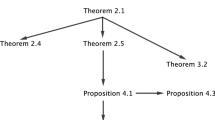Abstract
A series of inequalities involving Stirling numbers of the first and second kinds with adjacent indices are obtained. Some of them show log-concavity of Stirling numbers in three different directions. The inequalities are used to prove unimodality or strong unimodality of all the subfamilies of Stirling probability functions. Some additional applications are also presented.
Similar content being viewed by others
References
Erdös, P. (1953). On a conjecture of Hammersley, J. London Math. Soc., 28, 232–236.
Goldberg, K., Newman, M. and Haynsworth, E. (1964). Combinatorial analysis, Handbook of Mathematical Functions, (eds. M., Abramowitz and I. A., Stegun), Chap. 24, National Bureau of Standards/Dover Publ., New York.
Hammersley, J. M. (1951). The sums of products of the natural numbers, Proc. London Math. Soc., Third Series, 1, 435–452.
Hardy, G. H., Littlewood, J. E. and Polyà, G. (1952). Inequalities, Subsections 2.22 and 4.3, Cambridge Univ. Press, Cambridge.
Jordan, C. (1947). Calculus of Finite Differences, Chelsea, New York.
Karlin, S. (1968). Total Positivity, Stanford Univ. Press, Stanford, California.
Keilson, J. and Gerber, H. (1971). Some results for discrete unimodality, J. Amer. Statist. Assoc., 66 (334), 386–389.
Knuth, D. E. (1967–1981). The Art of Computer Programming, Vol. 1–3, Addison-Wesley, Reading, Massachusetts.
Kurtz, D. C. (1972). A note on concavity properties of triangular arrays of numbers, J. Combin. Theory Ser. A, 13, 135–139.
Lieb, E. H. (1968). Concavity properties and a generating functions of Stirling numbers, J. Combin. Theory, 5, 203–206.
Neuman, E. (1985). On generalized symmetric means and Stirling numbers of the second kind, Zastowania Matematyki Applicationes Mathematicae, 18–4, 645–656.
Nishimura, K. and Sibuya, M. (1988). Occupancy with two types of balls, Ann. Inst. Statist. Math., 40, 77–91.
Patil, G. P. and Wani, J. K. (1965). On certain structural properties of the logarithmic series distribution and the first type Stirling distribution, Sankhyā Ser. A, 27, 271–280.
Riordan, J. (1958). An Introduction to Combinatorial Analysis, Wiley, New York.
Sibuya, M. (1986). Stirling family of probability distributions, Japanese J. Applied Statist., 15, 131–146 (in Japanese. An English summary appeared in Proceedings of the Second Japan-China Symposium on Statistics, Kyushu Univ., Nov. 1986).
Yanagimoto, T. and Sibuya, M. (1972). Stochastically larger component of a random vector, Ann. Inst. Statist. Math., 24, 259–269.
Author information
Authors and Affiliations
About this article
Cite this article
Sibuya, M. Log-concavity of stirling numbers and unimodality of stirling distributions. Ann Inst Stat Math 40, 693–714 (1988). https://doi.org/10.1007/BF00049427
Received:
Revised:
Published:
Issue Date:
DOI: https://doi.org/10.1007/BF00049427



